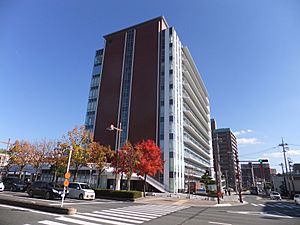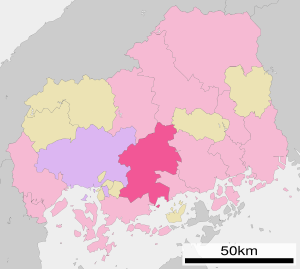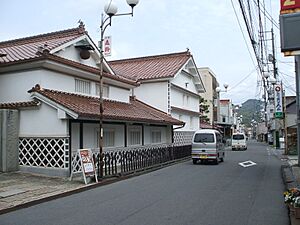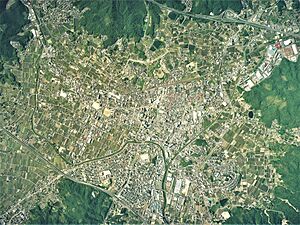Higashihiroshima facts for kids
Quick facts for kids
Higashihiroshima
東広島市
|
|||||||||||
|---|---|---|---|---|---|---|---|---|---|---|---|

Higashihiroshima City Hall
|
|||||||||||
|
|||||||||||
 |
|||||||||||
| Country | Japan | ||||||||||
| Region | Chūgoku (San'yō) | ||||||||||
| Prefecture | Hiroshima | ||||||||||
| Area | |||||||||||
| • Total | 635.16 km2 (245.24 sq mi) | ||||||||||
| Population
(April 30, 2023)
|
|||||||||||
| • Total | 190,186 | ||||||||||
| • Density | 299.4301/km2 (775.520/sq mi) | ||||||||||
| Time zone | UTC+09:00 (JST) | ||||||||||
| City hall address | 8-29 Saijō Sakaemachi, Higashihiroshima-shi, Hiroshima-ken 739-8601 | ||||||||||
| Climate | Cfa | ||||||||||
|
|||||||||||
Higashihiroshima (which means "East Hiroshima" in Japanese) is a city in Hiroshima Prefecture, Japan. As of April 2023, about 190,186 people live there. The city covers an area of about 635 square kilometers (245 square miles).
Contents
Geography of Higashihiroshima
Higashihiroshima stretches from the coast of the Seto Inland Sea up into the hills. It has a big difference in how high the land is. The city includes the Saijō Basin, which is the largest flat area in the prefecture. This basin is also the main city center.
Small basins are scattered around the main one. Rivers like the Numata, Kurose, and Seno flow through the area. Because it's in a basin, the temperature changes a lot between day and night, and also between summer and winter.
Neighboring Cities and Towns
Higashihiroshima shares borders with several other places in Hiroshima Prefecture:
Climate in Higashihiroshima
Higashihiroshima has a humid subtropical climate. This means it has cool or mild winters and hot, humid summers. The average temperature each year is about 13.7 degrees Celsius (56.7°F).
The city gets about 1457.6 mm (57.38 inches) of rain per year. July is usually the wettest month. August is the warmest month, with an average temperature of about 25.8 degrees Celsius (78.4°F). January is the coldest, averaging about 2.3 degrees Celsius (36.1°F).
The highest temperature ever recorded was 37.0 degrees Celsius (98.6°F) on July 17, 1994. The coldest was -12.6 degrees Celsius (9.3°F) on January 31, 1981.
| Climate data for Higashihiroshima (1991−2020 normals, extremes 1979−present) | |||||||||||||
|---|---|---|---|---|---|---|---|---|---|---|---|---|---|
| Month | Jan | Feb | Mar | Apr | May | Jun | Jul | Aug | Sep | Oct | Nov | Dec | Year |
| Record high °C (°F) | 18.3 (64.9) |
20.7 (69.3) |
23.4 (74.1) |
29.2 (84.6) |
31.4 (88.5) |
34.0 (93.2) |
37.0 (98.6) |
36.7 (98.1) |
35.5 (95.9) |
29.9 (85.8) |
26.5 (79.7) |
19.9 (67.8) |
37.0 (98.6) |
| Mean daily maximum °C (°F) | 7.7 (45.9) |
8.9 (48.0) |
12.8 (55.0) |
18.7 (65.7) |
23.6 (74.5) |
26.3 (79.3) |
29.9 (85.8) |
31.5 (88.7) |
27.4 (81.3) |
21.9 (71.4) |
15.9 (60.6) |
10.1 (50.2) |
19.6 (67.2) |
| Daily mean °C (°F) | 2.3 (36.1) |
3.2 (37.8) |
6.6 (43.9) |
12.1 (53.8) |
17.3 (63.1) |
21.2 (70.2) |
25.0 (77.0) |
25.8 (78.4) |
21.8 (71.2) |
15.6 (60.1) |
9.5 (49.1) |
4.4 (39.9) |
13.7 (56.7) |
| Mean daily minimum °C (°F) | −2.6 (27.3) |
−2.1 (28.2) |
0.6 (33.1) |
5.4 (41.7) |
11.1 (52.0) |
16.6 (61.9) |
21.0 (69.8) |
21.5 (70.7) |
17.1 (62.8) |
10.0 (50.0) |
3.7 (38.7) |
−0.8 (30.6) |
8.5 (47.2) |
| Record low °C (°F) | −12.6 (9.3) |
−11.9 (10.6) |
−7.3 (18.9) |
−3.8 (25.2) |
−0.3 (31.5) |
7.9 (46.2) |
12.7 (54.9) |
13.4 (56.1) |
4.5 (40.1) |
−0.8 (30.6) |
−4.3 (24.3) |
−8.7 (16.3) |
−12.6 (9.3) |
| Average precipitation mm (inches) | 46.9 (1.85) |
60.0 (2.36) |
105.0 (4.13) |
120.6 (4.75) |
147.7 (5.81) |
207.4 (8.17) |
253.0 (9.96) |
131.3 (5.17) |
158.2 (6.23) |
106.0 (4.17) |
67.4 (2.65) |
54.3 (2.14) |
1,457.6 (57.39) |
| Average precipitation days (≥ 1.0 mm) | 6.1 | 7.4 | 9.9 | 9.5 | 9.1 | 11.0 | 10.8 | 8.3 | 9.2 | 7.3 | 6.7 | 6.5 | 101.8 |
| Mean monthly sunshine hours | 134.6 | 133.8 | 170.4 | 188.4 | 204.5 | 142.2 | 163.9 | 194.3 | 149.5 | 167.2 | 143.2 | 133.6 | 1,925.6 |
| Source: Japan Meteorological Agency | |||||||||||||
Population Changes Over Time
According to Japanese census data, the population of Higashihiroshima was 196,608 people in 2020. The city has been counting its population since 1960.
| Historical population | ||
|---|---|---|
| Year | Pop. | ±% |
| 1960 | 97,063 | — |
| 1965 | 91,630 | −5.6% |
| 1970 | 93,587 | +2.1% |
| 1975 | 108,219 | +15.6% |
| 1980 | 120,871 | +11.7% |
| 1985 | 131,159 | +8.5% |
| 1990 | 142,088 | +8.3% |
| 1995 | 165,153 | +16.2% |
| 2000 | 175,346 | +6.2% |
| 2005 | 184,430 | +5.2% |
| 2010 | 190,043 | +3.0% |
| 2015 | 192,907 | +1.5% |
| 2020 | 196,608 | +1.9% |
| Higashihiroshima population statistics | ||
History of Higashihiroshima
The area where Higashihiroshima is located was once part of an ancient province called Aki Province. Scientists have found signs that people have lived here for a very long time. The oldest remains of homes are about 22,000 years old!
There are also many traces from the Yayoi period and the Kofun period. These include the Mitsushiro Kofun, which is a very important historical site. During the Nara period, an old highway called Sanyōdō passed near what is now Saijō Station. This road connected different parts of Japan.
The Aki Kokubun-ji temple was also in this area. For a long time, the main government office of the province was here before it moved in the Heian period. Later, during the Muromachi period, the Ouchi clan ruled the area. They built Kagamiyama Castle, and its ruins are now a National Historic Site. After 200 years, the Mōri clan took over during the Sengoku period.
When the Tokugawa Shogunate began, the area became part of the Hiroshima Domain.
How Higashihiroshima Grew
The city of Higashihiroshima as we know it today was formed through several mergers:
- On April 1, 1889, the town of Saijō was officially created.
- On April 20, 1974, Saijō merged with three other towns: Shiwa, Takaya, and Hachihonmatsu. Together, they formed the new city of Higashihiroshima.
- On February 7, 2005, Higashihiroshima grew even more. It merged with five more towns: Kurose, Kōchi, Toyosaka, Fukutomi, and Akitsu.
Economy and Industries
Higashihiroshima has a mix of different businesses and industries. One of its most famous products is sake, which is Japanese rice wine. Sake brewing is still a very important industry here.
Other important industries include making computer chips (semiconductors), car parts, special equipment, and even bricks. Farming, especially growing rice, is also a big part of the economy. Some people in Higashihiroshima also work in commercial fishing.
Education in Higashihiroshima
The city of Higashihiroshima has many schools for young people. There are 37 public elementary schools and 15 public junior high schools, all run by the city government. The Hiroshima prefectural Board of education operates six public high schools and one school that combines middle and high school.
There are also two private middle schools and two private high schools. For students who want to continue their studies, Higashihiroshima is home to several universities, including Hiroshima University, Elisabeth University of Music, Kindai University, and Hiroshima International University.
Transportation
Train Travel
You can travel by train in Higashihiroshima using the JR West lines.
- San'yō Shinkansen (bullet train): The Higashi-Hiroshima station is here.
- San'yō Main Line: This line has several stations in the city, including Hongō, Kōchi, Nyūno, Shiraichi, Nishitakaya, Saijō, Jike, and Hachihonmatsu.
- Kure Line: This line has stations like Akitsu and Kazahaya.
Major Roads
Several important roads pass through Higashihiroshima:
- San'yō Expressway
- Route 2
- Route 185
- Route 375
- Route 432
- Route 486
Friendship Cities
Higashihiroshima has special friendship connections with cities in other countries:
 Marília, São Paulo, Brazil (since November 2, 1980)
Marília, São Paulo, Brazil (since November 2, 1980) Deyang, Sichuan, China (since October 14, 1993)
Deyang, Sichuan, China (since October 14, 1993) Virginia Beach, Virginia, United States (since October 26, 1993)
Virginia Beach, Virginia, United States (since October 26, 1993)
Fun Places to Visit
Higashihiroshima is well-known for making sake. Near the JR Saijō Station, you can walk along Sakagura Dōri, which means "Sake Storehouse Road." Here, you'll see ten famous sake breweries with their unique white-lattice walls and red-tiled roofs. Every October, the city holds an exciting sake festival!
Famous People from Higashihiroshima
Many talented people come from Higashihiroshima, including:
- Reizo Fukuhara, a Japanese soccer player.
- Yūki Himura, a Japanese comedian and actor.
- Ryuichi Hirashige, a former Japanese soccer player.
- Akira Ibayashi, a Japanese soccer player.
- Koichi Isobe, a former professional baseball player.
- Akinoshima Katsumi, a former sumo wrestler.
- Daiki Nishiyama, a Japanese judoka (martial artist).
- Ayako Okamoto, a professional golfer who is in the World Golf Hall of Fame.
- Ryuji Sainei, a Japanese actor.
- Toru Takahashi, a Japanese racing driver.
- Yasuyuki Yamauchi, a Japanese professional baseball player and coach.
- Hirotake Yano, the founder of the Daiso discount retail chain.
See also
 In Spanish: Higashihiroshima (Hiroshima) para niños
In Spanish: Higashihiroshima (Hiroshima) para niños







